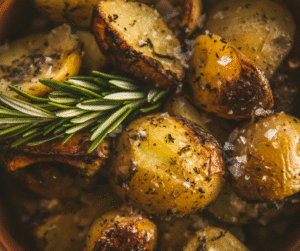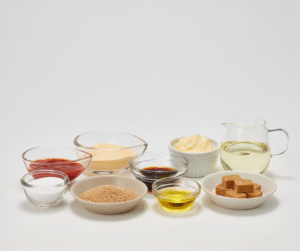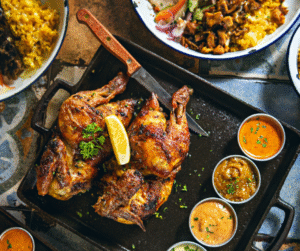Winter Wellness, Moroccan Magic & Content Marketing Wins

#DineJoziStyle: Moroccan Magic
Moroccan cuisine is truly remarkable for many reasons. I love its flavour, which is both aromatic and spicy, hearty and good, sweet, colourful, and layered. When you consider the spices they use, it’s easy to see why. I particularly enjoy the combination of cumin and cinnamon, often enhanced with a touch of turmeric or saffron. The way Moroccan dishes are cooked is also renowned for their immune-boosting properties.
There’s something special about how Moroccans garnish, plate, and serve their food. While I may not know everything about Moroccan cuisine, the attention to detail in presentation is evident. For instance, when you’re making a soup or a stew, adding a handful of Moroccan spices and garnishes can truly elevate the dish. Moroccans are very generous with their garnishes. Think about adding lamb to a couscous dish, which you can further enhance with vegetables or meat.
The Spice Rack: Your Moroccan Pantry Essentials
You likely already have many of the essential Moroccan spices in your cupboard. I adore cumin for its earthy and warm notes – it adds an interesting sweetness to savoury dishes. Turmeric and paprika are also common. I find turmeric brilliant for that golden colour, though it has a subtle earthy, bitter undertone, so less is more with turmeric. And of course, you can never go wrong with garlic and ginger. When experimenting with Moroccan recipes, I’m happy to use both dried and fresh ginger. The hint is in the word: dried ginger offers a spicier, earthier flavour profile, while fresh ginger lightens and brightens the dish and is very good for digestion. You can, of course, use any herbs and spices you have on hand.
Two ingredients I particularly love when exploring Moroccan cuisine are Harissa paste and preserved lemons. You don’t have to use Harissa exclusively for Moroccan dishes; I often buy a tub and smear it over everything. It’s effortless and delicious, offering a bit of spice without being overwhelming, and you can even personalise its heat to your preference.
Preserved lemons are intensely fragrant and salty, and you can even make them yourself. I’ve always loved the idea of preserved lemons, and adding the zest of a lemon offers a nice workaround if you don’t have them.
Sweet and Savoury Combinations
One aspect I especially appreciate about Moroccan cuisine is its clever use of dried fruit. If you have any in your pantry, they can transform a dish. Apricots, for example, pair wonderfully with everything – chicken, lamb, you name it. Dried apricots, in particular, are delicious. Prunes work incredibly well with canned lamb, and dried apples are fantastic with pork. It might seem surprising, but even Afrikaans cuisine often incorporates dried fruit.
Classic Dishes and Creative Twists
A classic Moroccan dish you might want to try is a chicken tagine. Here, you can use those preserved lemons with olives, or as I like to do, roast the lemons with the chicken, depending on my cooking method. You can chop up the lemons in two ways.
If you’re new to Moroccan cuisine and feel a bit intimidated, a great starting point is to take your favourite dish – a casserole or a stew – and cook it as you normally would. Then, add a Moroccan twist! Before I get ahead of myself, I often caramelise dried fruit a bit before layering it in. You could also create a smoky eggplant and tomato dip to serve with bread, perhaps with some herb salt.
Moroccan cuisine also shines in its ability to enhance desserts. If you’re a fan of poached pears, try poaching them in rooibos tea with cinnamon, cardamom, star anise, and a hint of fresh chilli. For something like date pudding or tipsy tart, you can amp up the flavours with cayenne pepper and ginger to bring some heat. Serve it warm with fresh cream or custard for a truly decadent treat.
While some people use rose or pink peppercorns in desserts for a sweet floral flavour, I still think they taste like pepper, even if they look pretty. However, a very traditional Moroccan ingredient is rose water or rose essence. I absolutely love rose water! It’s incredibly refreshing in summer for cordials. A simple cheat I use is adding a few drops to a glass of soda water – just remember, less is more, otherwise it can taste like soap. If I’m feeling extravagant, I’ll use lemonade. Once you start experimenting, you’ll find countless ways to incorporate rose water into dishes, like adding a splash to vanilla ice cream.
Finally, an interesting way to bring some heat into your winter kitchen is with chilli and chocolate. Make a dark chocolate pot or mousse and infuse it with cinnamon, espresso or strong instant coffee, and a dash of chilli oil. The oil is a great carrier for flavour.
Boosting Your Immunity This Winter: Essential Wellness Tips
As winter approaches, bringing with it the cold and flu season, it becomes even more crucial to prioritise our health. One of the primary reasons experts consistently advise staying hydrated during the colder months is the dry air. This dry environment thickens the mucus in our airways, making it challenging to swallow. Should one contract the flu virus or the cold bacteria (as colds are bacterial), the thickened mucus can unfortunately create easier pathways for these pathogens to establish themselves, making them harder for the body to eliminate.
To assist your body in fending off colds and flu during the chilly winter months, here are some timeless tips to bolster your immunity:
1. Fuel Your Body Healthily: Nourishing your body with wholesome food is fundamental. While I do not advocate for gluttony, I am someone who genuinely enjoys eating. My philosophy is that one should never have to eat the same meal twice, a principle I apply in various aspects of my life. Even when discussing my culinary habits, I emphasise stocking up. Whatever you prepare, consider cooking it in bulk and freezing portions. This ensures you always have a ready meal on hand. If you are making the effort to cook, it is practical to prepare a little extra. Should you experience a cold or flu, having pre-prepared meals is incredibly beneficial. Freezing and repurposing meals offers numerous advantages.
2. Prioritise Hydration: Beyond simply drinking ample water, which admittedly becomes more challenging in winter due to the cold, it is certainly beneficial to consume more teas, broths, and even warm lemon water. This approach provides both hydration and a good source of Vitamin C.
3. Embrace Immune-Boosting Foods: My enjoyment of mixing fruit with savoury, spicy flavours is something I embrace as an immune-boosting practice. The cooking methods found in certain cuisines, for example, are also known for their immune-boosting properties. Supplementation, such as teas, tinctures, or supplements, can be considered, but I would always recommend consulting your doctor or pharmacist before commencing any new supplement regimen.
4. Nurture Your Gut Health: Maintaining a healthy gut is paramount, as a healthy gut equates to a strong immune system. Incorporating probiotics, such as yoghurt, or preparing gut-friendly dishes in a slow cooker are excellent strategies. Freezing, de-gating fibre, and repurposing these meals are all viable options. While we should ideally be maintaining our gut health 365 days a year, the basic principle remains: focus on foods that support a healthy digestive system. Prebiotics and probiotics are not only beneficial for your digestive system but also crucial for your immune system.
5. Manage Stress Effectively: Equally important for overall wellness is managing your stress levels. Chronic stress can significantly compromise your immune system. Should you require assistance with stress management, consider incorporating practices such as deep breathing exercises, mindfulness, or journaling – anything that aids in relaxation.
6. Warmth and Convenience: In winter, laziness can set in, often leading to a desire to simply throw everything into a slow cooker or oven, leave it, and forget about it. Many common kitchen ingredients, particularly spices, lend themselves well to this.
As we navigate the colder months, remember these straightforward strategies for boosting your immunity and maintaining your well-being. Keeping hydrated and providing your body with the necessary nutrients are fundamental steps in fending off winter ailments.
Insights on Content Creation
Creating content is a dynamic process, and I’ve found a system that works well for me.
I always start by creating my content calendar in advance. This means I know exactly what I’ll be doing for each month of the year. One of the things I appreciate about planning my content ahead is that it allows me to identify overarching themes. This helps me decide, for example, what kind of vegetables I’ll be focusing on for the year, and it helps me realise if I’ll be focusing on home cooking rather than fine dining.
While I’m mapping out the content I’ll be creating, I also consider what can serve as a counterpoint. For instance, if we’re talking a lot about food, I might then think about shifting the conversation to healthy food.
I generally build my content calendar by starting at the end of the year, knowing that December will be all about Christmas. Then, I work my way forwards. For me as a content creator, this provides a skeleton to work from. If I’m short on ideas, this structure is invaluable.
With my radio show, for example, I know that every week I’ll be discussing interesting sides. Every alternative week, I’ll be talking about health, and I’ll also be discussing wealth, art, and entertainment. This consistent thematic approach helps streamline everything I do throughout the year.
Content Development and Adaptation
I recently celebrated a decade of Jersey style, marking 10 years of producing front-row, first-class, and five-star content. This past year, I made a significant shift: I’m no longer sharing curated content or publishing recipes for brands that don’t have a budget.
When it comes to the type of content needed, it could be editorial, visual (photographic or video).






